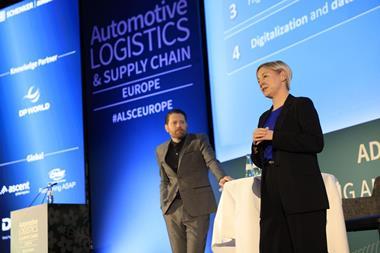With production in eastern and central Europe predicted to grow further, investment in logistics operations must be made to cope with the flow of exports.
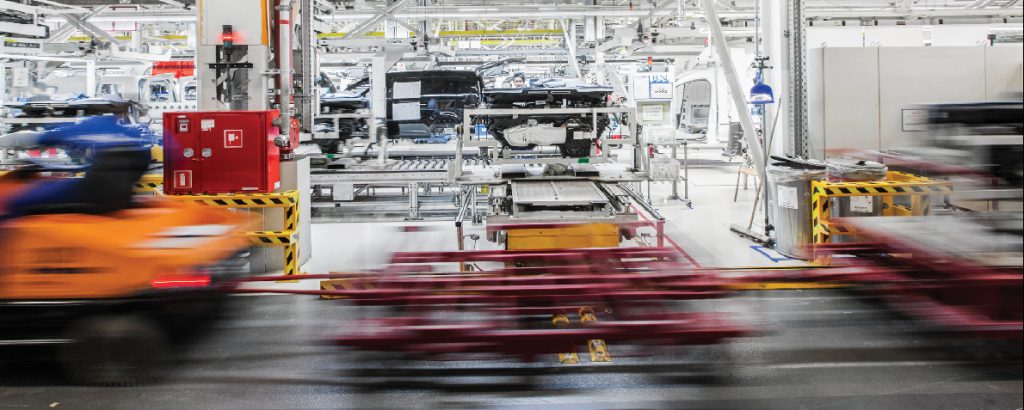 Within the borders (and non-borders) of the European Union and its immediate trading partners, the past two decades have seen a gradual, but undeniable expansion of automotive production in central and eastern countries. This has occured even as production across most western countries, with the exception of Germany, has declined. Europe’s largest producers, including the Volkswagen Group and Renault, have expanded their footprints in the region considerably. As part of such OEM investment, local brands like Skoda and Dacia have been able to grow production along with parts and vehicle exports on a global scale. Meanwhile, premium German brands have also recently expanded compact car production there.
Within the borders (and non-borders) of the European Union and its immediate trading partners, the past two decades have seen a gradual, but undeniable expansion of automotive production in central and eastern countries. This has occured even as production across most western countries, with the exception of Germany, has declined. Europe’s largest producers, including the Volkswagen Group and Renault, have expanded their footprints in the region considerably. As part of such OEM investment, local brands like Skoda and Dacia have been able to grow production along with parts and vehicle exports on a global scale. Meanwhile, premium German brands have also recently expanded compact car production there.
Mapping the supply chain for this region is increasingly complex. Investment from the likes of Volkswagen, Mercedes-Benz and their tier suppliers has expanded links between the German industrial heartland and across its borders to the Czech Republic, Slovakia and Hungary, while there are also further clusters between Romania and France. Exports of parts and vehicles move mostly to western Europe and ports, with an increasingly global reach, including complete knockdown kits (CKD) to Russia, Asia and Africa.
Indeed, because of its myriad supply chain and market links, some companies take different approaches to grouping the region. While this article focuses mainly on the countries that joined the EU since 2004 (or have been in the process of applying), Renault has recently grouped Romania and Bulgaria into its ‘Eurasia’ region, which now includes Turkey, Russia and Central Asia. Logistics provider Gefco has also split the region, grouping Germany together with most of central Europe, the Balkans and the Middle East in its ‘CEBAME’ zone, but putting the Baltic States in its ‘1520’ zone with Russia and Central Asia.
Regardless of groupings, logistics services need to match the sophistication of the region’s production and exports. Automotive manufacturers and logistics providers are thus reducing waste in their supply chains, including making investments in consolidation centres, IT systems and transport equipment. Many manufacturers are also looking increasingly towards intermodal parts transport and vehicle exports by rail.
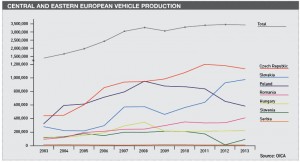
From out of the shadows
However, despite considerable infrastructure investments, including EU funding, there remain transport gaps across the region. Likewise, the relatively low local sales market – still dominated by used cars – prevents the penetration of some advanced vehicle logistics services, such as post-production accessories and modification. The amount of intra-regional supply flows, whether of parts or vehicles, also remains low.
There may also be deeper questions about the region’s competitiveness following years of price and labour cost growth. A recent report by the Boston Consulting Group revealed that Poland and the Czech Republic are now ranked similarly or even costlier than the US for manufacturing and labour costs, once adjusted for productivity. The overall weakness in European markets, especially in Russia, also undermines the countries’ strength in logistics proximity.
Russia could cast a longer shadow as well. Should the crisis with Ukraine lead it to cut gas supplies further, central and eastern European countries will suffer, too. Previous disputes have led to limited supply in countries like Slovakia, requiring rationing in its factories.

According to OICA figures, between 1997 and 2013 production in the Czech Republic, Slovakia, Poland, Hungary, Slovenia, Serbia and Romania grew from 1.1m units per year to more than 3.4m. Production in western Europe has dropped from 15.8m to 12.7m units in the same period.
Eastern countries’ headline growth masks some specific troubles – Opel, Fiat and Suzuki have not recovered from drops in production in Poland and Hungary following the financial crisis, for example – but on the whole there has been impressive value added to the supply chain.
Sales across the region have also been growing again, albeit from a low level. In the first six months of 2014, new vehicle registrations accelerated more than 17.4% in 13 central and eastern European countries that have joined the EU since 2004, reaching 457,700 units. In the rest of western Europe, sales in the same period grew 5.5% to nearly 6.4m units.
Hungary for intermodal
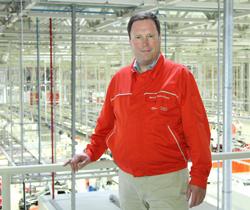
Considering the plant’s links to Germany and European ports, Berndt would like to increase the use of rail transport for the plant. “Transportation costs such as rising fuel prices and CO2 emission regulations affect our competitiveness. Within the next few years, our goal is to increase our use of rail to 50% of all deliveries,” says Berndt.
Last October, Audi opened a 72,000 sq.m logistics centre operated by Panopa Logistics. It also introduced a pick-by-voice warehousing system for the Gyor operation and is currently developing a global transport label, which aims to reduce handling and increase transparency. “In order to achieve these results, we must also improve our partners’ data quality,” explains Berndt.
Audi’s expansion in Hungary came on the heels of its premium compatriot rival, Mercedes-Benz, which opened its plant in Kecskemet, 85km southeast of Budapest, in March 2012. Similar to Audi, most of the supplies for the new generation of Mercedes-Benz compact cars built at the plant are from Germany, although it also has a number of important local suppliers. A company spokesperson says that of its Hungarian suppliers, six are located at the plant’s premises; two are within 10km of the plant and 17 are from other regions of Hungary.
Like Audi, the Mercedes-Benz plant has also developed its rail network. The production network of the Mercedes-Benz compact car plants in Rastatt, Germany and Kecskemet is part of the Daimler ‘Rail Net’ system. An east-west rail connection complements the north-south connection between the powertrain and car plants in Germany. Body parts, engines, gearboxes and other components ship from Germany to Kecskemet by rail.
Since last year, Mercedes-Benz has been transporting most vehicles built in Hungary to Germany by rail. This should lead to annual CO2 savings of up to 60,000 metrics tonnes, according to the spokesperson. The Kecskemet plant works with five logistics providers that handle different functions: incoming supplies by train or truck; processing empty containers; sequencing parts; and shipping finished vehicles. It produced more than 40,000 units in 2012, which grew to 109,000 last year and is growing again in 2014.
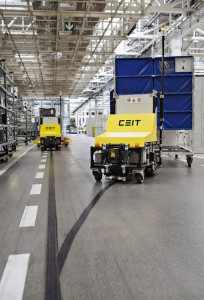
As manufacturers in central and eastern Europe see their supply chains intertwine with those of neighbouring plants in Germany and western Europe, as well as global production sites, executives are noting an increase in logistics complexity. David Strnad, manager of logistics planning at Volkswagen Group-owned Skoda Auto in the Czech Republic, says that Skoda has more than 1,300 suppliers for its European production, including 44% from Germany, 20% from the Czech Republic and 2% from China. The percentage of overseas parts is gradually increasing.
“Our logistics network has suffered due to the increase in the number of suppliers, the increasing complexity of parts and the negative macroeconomic conditions in some markets,” says Strnad. The carmaker’s increase in CKD material to production plants in Ukraine, Russia and India has also influenced its logistics network significantly. “We expect our logistics network to grow dynamically in terms of increasing volumes, distances and number of suppliers from overseas and other low-cost destinations.”
Strnad says Skoda’s use of crossdock centres to consolidate supplier parts is increasing substantially. It is also turning to IT solutions to help manage complexity. “During the past year, we started to focus more on group-wide information technology solutions,” he notes. “We expect to transition to a uniform SAP interface within the next five years.”
"Although Hungary and the Czech Republic have a relatively well-established road network, Poland still lags... Romania, Bulgaria and Croatia must do even more to develop their infrastructure" - Rémy Hoeffler, Panopa Logistics
As logistics networks grow and become more sophisticated, regional infrastructure is also under more pressure. One OEM experiencing this challenge is Hyundai Motor Manufacturing Czech (HMMC) in Nosovice, near Ostrava, which handles more than 700 trucks daily, according to Jan Planka, manager of production control. Local parts from the EU follow a just-in-time and just-in-sequence process that consists of low levels of on-site stock, frequent truck deliveries, nearby suppliers and real-time information flow. Modules such as chassis, cockpits, front ends and seats ship by conveyor from onsite suppliers in sequence to the assembly line.
Inbound containers from South Korea arrive at the ports of Hamburg and Koper, then move by train. However, Hyundai is increasing local sourcing. “For European parts we develop routes, delivery schedules and, in particular, packaging,” says Planka. “As our proportion of localised parts increases, it places pressure on the local infrastructure.”
One bottleneck, says Planka, is the connection to Kia Motors Slovakia in Zilina. The Kia plant is part of the Hyundai group and a powertrain supplier to HMMC, and the latter’s customer for transmissions from Nosovice.
“The long-term problem is the lack of a highway link between our plants and our suppliers in western Slovakia,” says Planka.

Logistics providers invest to the east
Tier one supplier Magna operates 120 plants in Europe, including around 20 in central and eastern Europe beyond Germany and Austria. Jörg Blechinger, director of Magna Logistics Europe, says around 80% of Magna’s inbound supplies to the region originate in Germany, Austria, Poland and the Czech Republic. Less than 20% are intra-regional, such as between Poland and the Czech Republic.
On the outbound side, Magna operates several just-in-sequence centres for carmakers, including in Mlada Boleslav, Czech Republic; Tychy and Poznan, Poland; Kecskemet, Hungary; and in Romania. “Our strategy is to produce next to the customer and we ship mainly JIS from these facilities. Approximately 90% of our outbound products ship by full truckload and 10% by less than truckload,” says Blechinger.
On the inbound side, one of Magna’s main challenges is to intensify its supply chain management in areas such as short-term planning, truck utilisation, pick-up management and track-and-trace. “We need to consolidate and bundle volumes,” says Blechinger. “With the market in Europe saturated or declining, the task is to reconfigure the supply chain.”
As part of Magna’s supply chain planning strategy, it has also improved its planning software solutions. “With the high complexity and variants of parts, there are many opportunities to get material into planning; for this, we need software tools, data management and data quality management,” says Blechinger.
Panopa is one of a number of logistics providers that has invested substantially in central and eastern Europe. Its customers include Volkswagen, Audi, Mercedes-Benz and Opel plants in Poland, the Czech Republic and Hungary, including 210,000 sq.m of warehouse space at five sites. In Gyor, it provides shuttle transport and warehousing for Audi and in Kecskemet it provides empty container management for Mercedes-Benz.
Other major 3PLs are also expanding in the region. Gefco’s Pierre-Jean Lorrain, director of the CEBAME zone, says the company’s growth here reached more than 10% in 2013-2014, which it expects to continue. In the Balkan region, Gefco handles imports through the port of Koper, Slovenia and recently opened a subsidiary in Croatia. Gefco has also been introducing further crossdocks in the Czech Republic, Romania and Poland within the past year. For example, its facility in Ostrava, Czech Republic links to new flows and is closer to its customers. “Last year, our business in Slovakia grew by 15%, in Bulgaria by 43% and in Hungary by 13%,” says Lorrain.
Gefco, owned 75% by RZD Russian Railways, is also increasing its connections to Russia; it ships production and spare parts from Poland, Slovakia, Hungary and Romania daily, flows which Lorrain admits are unbalanced.
With manufacturers looking to increase their intermodal material flow to and from central Europe, other providers are increasing their investments in the region. Poland-based railway carrier PKP Cargo serves a number of countries, including the Czech Republic, Hungary and Slovakia. PKP Cargo is investing in intermodal transport in Poland, whose importance is growing, according to chief executive officer Adam Purwin. Already this year, PKP Cargo expects to provide 28,000 open railway wagons – 15% more than in 2013.The company is close to finalising the purchase of 330 new well wagons for intermodal transport. “The stable growth of the network is one key element of our strategy, which involves international expansion. In addition to Poland, we can now operate in eight other EU countries,” says Purwin.
Moving outbound by rail and back
Because production in central and eastern Europe is mostly for export, vehicle logistics connections to western European markets or ports are vital. Wolfgang Göbel who is both head of logistics at Mosolf as well as managing director of Mosolf Automotive Railway, the company’s rail division, says that Mosolf’s rail wagon fleet will grow from 300 units to 500.
The company serves a number of carmakers by rail in eastern Europe, including shunting services for Skoda, moving vehicles to Germany from the Fiat plant in Tychy and from the Opel plant in Gliwice, Poland. It also ships from Tychy to the port of Antwerp for export via Grimaldi Lines. From Fiat’s plant in Kragujevac, Serbia, it ships finished vehicles to the port of Bar, Montenegro for exports also handled by Grimaldi Lines. Rail shipments from the Mercedes-Benz Kecskemet plant began two years ago and have grown strongly.
Because production in the region typically moves long distances, Göbel says it is better to use rail to avoid empty truck mileage. “We can balance the costs better over long distances by using rail. This is difficult with truck due to the high empty mileage,” he explains. However, balancing rail volumes becomes its own challenge, he says, particularly in the Balkan states.
Uwe Seliger, head of the business unit for central eastern Europe and Russia at BLG Automobile Logistics, says the company’s rail network is growing, with its latest figures showing more than 500,000 units handled. BLG works with carmakers to transport cars in a number of central European countries by truck, however it does not plan to expand its rail operations to serve smaller markets in the region, says Seliger. Rather, much of its focus is shipping vehicles within and from Germany, although shipments also move through eastern Europe by rail to Russia.
Taking to truck
Road transport is also developing further for vehicle logistics to and from eastern Europe. Poland-based carrier Adampol serves assembly plants for Fiat, Opel and Volkswagen in Poland, Hyundai in the Czech Republic, Kia in Slovakia and Suzuki and Mercedes-Benz in Hungary. It is also a major provider for moving vehicles and knockdown kits to Russia, mainly through its multimodal terminal in Malaszewicze, Poland near the Ukrainian and Belorussian border. Commercial director Barbara Koncewicz says the company handles 3,000 finished vehicles alone each month from the Czech Republic to Russia via the terminal. Adampol also operates terminals in Gdansk, which serves Poland, Ukraine and Baltic countries.
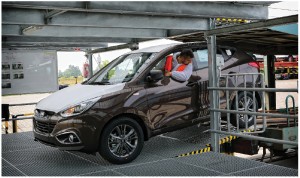
Adampol is also a 3PL provider for rail shipments. “Two main factors drive demand: volume and regularity. For volume, the best solution is to use rail where there is the possibility of a systematic flow,” Koncewicz says.
Adampol has extended the railway in Malaszewicze to use more trains from the Czech Republic and Hungary and to send wagons directly to Russia. This requires a special steel ramp for loading cars on Russian double-deck rail wagons. Koncewicz says the terminal is an important tool to reduce empty miles in moving to Russia.
“To reduce empty mileage, we shortened our truck’s travel radius and we use more than one truck to haul a single shipment from the Czech Republic to Russia, for example,” she says. “We use our fleet for shorter runs and pick up and deliver within the same zone. Another group of trucks handles a different zone; this improves pick-up times.”
With its production and supply links to the rest of Europe, as well as to market links with Russia, such logistics engineering is essential to keeping manufacturing and distribution competitive in central and eastern Europe. As such, the opportunities remain strong for logistics providers. Assembly is set to rise as well – BLG expects production in the region to grow 25% by 2018, according to Seliger – and with that rise, the connections across Europe and beyond will need to strengthen further.
Christopher Ludwig contributed to this report.

























![Global[1]](https://d3n5uof8vony13.cloudfront.net/Pictures/web/a/d/s/global1_726550.svgz)










